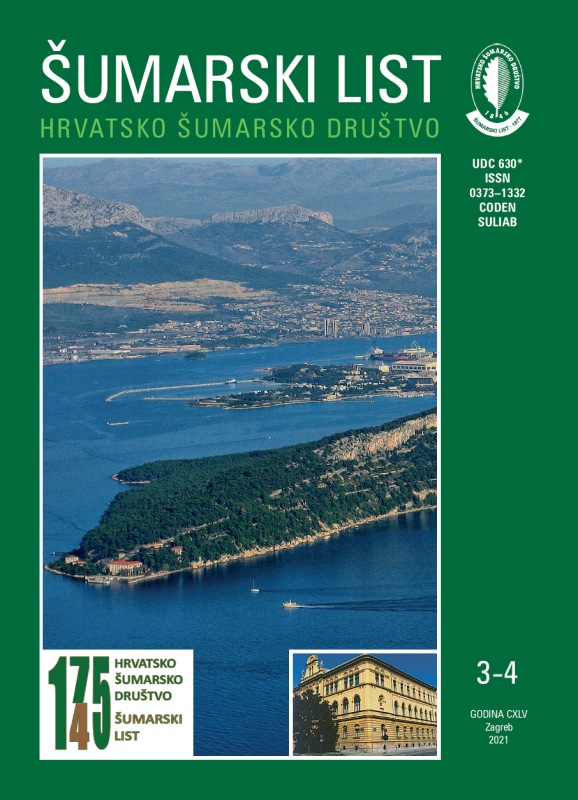
broj: 3-4/2021
pdf (11,5 MB) |
|
||||||||||||||
| RIJEČ UREDNIŠTVA | ||
| Uredništvo | ||
| Misunderstanding pdf HR EN | 113 | |
| IZVORNI ZNANSTVENI ČLANCI | ||
| Dino Hadžidervišagić, Azra Čabaravdić | UDK 630* 272 (001) https://doi.org/10.31298/sl.145.3-4.1 | |
| Importance and structural diversity of trees in a historical park pdf HR EN | 117 | |
| Dušan Jovanović, Milan Gavrilović, Mirko Borisov, Miro Govedarica | UDK 630*902 (001) https://doi.org/10.31298/sl.145.3-4.2 | |
| Deforestation monitoring with Sentinel 1 and Sentinel 2 images – the case study of Fruška gora (Serbia) pdf HR EN | 127 | |
| PRETHODNO PRIOPĆENJE | ||
| Boris Miklić, Anja Žmegač, Domagoj Trlin , Marko Orešković, Stjepan Mikac, Igor Anić | UDK 630* 111.8 https://doi.org/10.31298/sl.145.3-4.3 | |
| Climate sensitivity of black pine (Pinus nigra Arnold.) chronology in the Northern Velebit pdf HR EN | 137 | |
| Jelena Kranjec Orlović, Ida Bulovec, Milivoj Franjević, Damjan Franjević, Josip Skejo, Marin Biliškov, Danko Diminić, Boris Hrašovec | UDK 630*232.3 + 442 https://doi.org/10.31298/sl.145.3-4.4 | |
| Preliminary results on narrow-leaved ash (Fraxinus angustifolia Vahl) and green ash (Fraxinus pennsylvanica Marshall) seed entomofauna in Croatia pdf HR EN | 147 | |
| Mirjana Stevanov, Albina Tarjan Tobolka, Ljubomir Kljajić, Martina Kičić, Max Krott | UDK 630*903 https://doi.org/10.31298/sl.145.3-4.5 | |
| Analysis of conflicing interests on the example of the special nature reserve in Serbia: empirically analytical approach pdf HR EN | 155 | |
| Erol Akkuzu, Mustafa Şahin, Abdullah Ugiş, Ebru Bal | UDK 630* 453 https://doi.org/10.31298/sl.145.3-4.6 | |
| Assesment of trap color and trap height above the ground on the capture of Ips sexdentatus and Thanasimus formicarius pdf HR EN | 169 | |
| PREGLEDNI ČLANCI | ||
| Damir Barčić, Vlado Habjanec, Željko Španjol, Mario Šango | UDK 630* 111.5 + 421 https://doi.org/10.31298/sl.145.3-4.7 | |
| Analysis of raising windbreaks on the mediterranean karst of Croatia pdf HR EN | 175 | |
| Summary Windbreaks are established as barriers of rows of trees or shrubs that are planted to reduce wind speed, reduce evapotranspiration, protect against aeolian erosion, while being used directly to protect crops and plantations and provide favorable habitat conditions. One of the essential preconditions for the success of belt raising is the use of indigenous species that are adapted to habitat conditions. Technologies and protection procedures can be focused on biological-technical procedures of afforestation and raising plantations with the aim of mitigating wind gusts. The goal of windbreaks and raising plantations with different species is shown in the following figures (Figures 3,4,5,6,7). The choice of plant species for raising plantations is conditioned by different climatic zones, biological and ecological characteristics of the species, but also the composition with other elements of the landscape. An important feature of windbreaks is their wind permeability and impact on wind speed. Permeability depends on the habitus of the plant, and the type of trees and shrubs. The density of the windbreak changes its impact and effectiveness; the permeable belt ensures a balanced distribution as part of the wind skips it and part passes through the belt. The wind protection is placed in the direction of the main wind. Technical wind protection procedures include the construction of barriers made of building materials such as brick, stone, timber, glass, hard plastic or a combination of several types of materials (Figures 1 and 2). Biological procedures in terms of species selection and consideration of habitat conditions are much more complex. All this in the context of frequent changes in the “wind structure” in the karst area. Belt lifting can be differentiated according to purpose and expected performance as follows: impermeable belt, semi-permeable and permeable belt. The establishment of windbreaks primarily reduces wind strength and reduces its speed. In this way, the climatic extremes associated with the stormy wind are alleviated (the karst is primarily a bora) and it affects the microclimatic conditions, which can ultimately ensure the protection of agricultural and forest land. Key words: wind; permeability; microclimate; erosion; soil protection | ||


